Interview with Aerodelft Managers of year ‘21 and ‘22
Author: Chaitanya Dongre, Kamalesh S. Ganapathy, Leonardo Times Editors
AeroDelft was founded on the principle of rethinking the way we propel our aircraft. They strive to prove and promote liquid hydrogen as an alternative to conventional fuels in aviation. We interviewed Rahiq Ullah, the Team manager of AeroDelft ‘21/22, and Wouter van Der Linden, the Team manager of AeroDelft ‘22/23. The interview was focused on their experiences, progress and goals.
Q. Everyone has heard or read about Project Phoenix. As the current manager, how do you look at this project? What are some of the fundamentals that you believe can be achieved by this project?
Wouter: We intend to build a liquid hydrogen-powered flying aircraft. Project Phoenix is a tool to achieve the objective of proving that it is feasible. We also hope to inspire the industry and persuade big players to recognize the potential of liquid hydrogen and, ultimately, create a more sustainable aviation sector.
Q. What served as the inspiration for Project Phoenix?
Rahiq: It dates all the way back to the Wright brothers’ pioneering powered flight, which was the first time that humans took to the skies. With that, they connected the world and revolutionized transportation. However, climate change is a drawback that came with it. Project Phoenix is viewed by us as a new revolution. A few years ago, engineers continued to rely on gradual changes, efficiency savings, and improved engines. But in order to achieve the climate targets, leave a lasting impression, and take steps toward a sustainable future, our founders believed that we must fundamentally rethink the way we propel our aircraft. The mythological bird known as the “Phoenix” represents the rebirth of the aviation industry’s revolution in a move towards a more sustainable future. Just as the Wright brothers did, we want to show that it is possible. Even if we have a smaller crew and astronomically less money than the giant aviation companies, we demonstrate what is achievable through sheer will and determination. We are currently not close to being as efficient as conventional propelling methods, but we have to start somewhere. This is the beginning of the development of hydrogen aircraft, but once we have proven that it is possible, then we want to move on to increasing efficiency.
Q. Can you shine some light on what was achieved by the team over the previous year?
Rahiq: Two teams were working on the same project, but they were building two different aircraft. One is a prototype, while the other is a full-scale model. The Phoenix prototype aircraft allowed AeroDelft to fly off the ground for the very first time. This flight was electrically powered by batteries, since even though we are advocating for hydrogen, we first needed to test its airworthiness, and see if it could fly the way we predicted. After this, we were able to start implementing the procedures for hydrogen. In parallel to the first flight campaign, the gaseous hydrogen powertrain has been designed and fully tested on a test bench as well. A significant accomplishment was that we also evaluated the flying profile on the test bench. On top of that, a challenging electrical component that we built can transition between electric and hydrogen power effortlessly. When it comes to liquid hydrogen, we have created outer tanks ourselves and have received the inner tank, which was welded. We anticipate developing this further. Additionally, we are designing a real full scale aircraft which is manned. We began with an aircraft made out of boxes last year and finished the electrical power system so that the aircraft could taxi.
Q. What factors contributed to the success of the team?
Rahiq: It has taken a lot of the previous teams’ hard work and extensive effort to develop AeroDelft and get to the point where we are currently, including building the prototype’s structure. We had the good fortune to take it up from that stage and continue pursuing AeroDelft’s ambition to make the prototype fly. In addition, we recently received the full-scale aircraft, giving us the privilege of taking over the project at a moment where we could work on both aircraft. What really characterizes us is our determination. The departments worked continuously from nine in the morning until ten in the evening, five days a week, and also on weekends whenever the aircraft hall was open. There have been moments when things seemed grim, but what really carried us through those times was the passion shown by so many of our team members, how they were prepared to make sacrifices, and gave it their all to get where we are now. The fact that we set some really ambitious objectives, and combined them with our drive and enthusiasm for improving aviation’s sustainability was what ultimately drove us to the limit. Working with the previous team was also beneficial to us. Everything, in some manner, contributed to the success of last year.
Q. What were some of the difficulties that the team faced?
Rahiq: Engineering projects usually turn out differently from how they were originally planned, despite your best planning efforts. We had intended on completing the flying prototype a little sooner, but due to external factors, including stakeholders and internal issues, we were only able to accomplish it in June, which was much later than initially expected. Consequently, all of our deadlines were stretched, and we had to adjust. The hardest part of managing failures is consistently keeping your team’s motivation strong. Because there are so many things going on and because you personally deal with all of the team’s issues, a lot may go wrong. It is a challenge to balance all of that and keep things running smoothly.
Q. What modifications to the aircraft’s design were necessary for liquid hydrogen propulsion to be conceivable as opposed to conventional designs?
Wouter: You need an electric motor and a lot of cooling capability for the liquid hydrogen system. Hydrogen as a gas does not have a good volumetric density when compared to kerosene. However, liquid hydrogen has a much better volumetric density, still not as good as kerosene, but it will allow us to use existing aircraft concepts and integrate hydrogen there. We design our own hydrogen system, but we mostly make use of pre-existing parts. We are not making The Flying V, for instance, but we are tackling one problem at a time instead of all at once.
One important thing that needs to be considered is the cooling system. We make use of a fuel cell, and it is important to ensure that it is properly cooled using a radiator. Furthermore, the switch between hydrogen and electric power is very seamless. This is not a change in aircraft design, it is just a change in the propulsion system, which is very novel. You cannot store liquid hydrogen in the wings as you would normally do with kerosene. In that sense, this would be a change to conventional aircraft design, as you need a compartment to store liquid hydrogen.
Q. What do you hope to achieve this year, and what are some of your goals for the next year?
Wouter: Currently, integrating the gaseous hydrogen powertrain into the prototype flight is the major objective. We are also working together to develop a liquid hydrogen powertrain, and flying this year on liquid hydrogen would be great if it were feasible. To then incorporate the hydrogen powertrain with full-scale flight the following year, it must first be developed on a test bed. This year we hope to start integrating the system. The last objective is to improve our visibility by increasing our reach and getting additional TV appearances in order to spread the word about AeroDelft.

Q. How big is AeroDelft currently and how many full or part-time workers do you have?
Wouter: This year we are with 43 people, and approximately half of them are full-time working for the team. Last year we had 56 people, of which 20 were full-timers and 36 were part-timers. Our workforce expands steadily throughout the year, so there might be some more people joining us as the year progresses. Currently, Aerospace engineering students make up 40% of the entire team, contrary to the usual majority they constitute.
Q. What do you look for in new team members?
Wouter: The most crucial quality to have is a love for aviation and sustainability. What we want is the determination to act on your passion and actually look to change the world. Of course, you should work hard and be knowledgeable, but enthusiasm and passion for hydrogen are the two things that matter most. We also require engineers from various faculties. The year of study is irrelevant. You can apply even if you are a first-year student with little to no academic background or education. The information from the second or third year is undoubtedly helpful, but if you’re motivated to acquire it, you can always do so. There is a steep learning curve but you have an entire team to work and learn with. Getting rejected this year does not decrease your chances of getting accepted the next year. The practical skills learned by the team members while working at AeroDelft cannot be obtained in the classroom and are sure to stay for life. Many alumni find part-time or full-time internships, even jobs in some cases, at our partners.
Q. In comparison to shipping massive quantities of dangerous liquid hydrogen to air bases all over the world, storing it, and securely refueling the aircraft, kerosene is just too cheap and convenient. How feasible do you think it is that aircraft will convert to a new form of propellant in the future?
Rahiq: Kerosene will stay as the cheapest option. It is very reliable and has been used for years on end, also because of its efficiency. But there is a price that has to be paid for sustainability, and that is where hydrogen comes in. On top of using liquid hydrogen, you can, for example, also use gaseous hydrogen and liquefy it at a later stage. I would not want to negate either of the options. And maybe, there could also be a possibility of having an electrolyser next to the airport.
Hydrogen gets a bit of a bad reputation. There are a couple of papers that say that either kerosene or hydrogen is not viable as they’re both flammable. Hydrogen can escape a bit easier as it is a smaller particle. In the end, there are advantages and disadvantages to both. The biggest advantage of hydrogen is sustainability and that’s what we want in the end.
Q. How long do you think it will be before you are able to achieve the phoenix full scale plane?
Rahiq: Flying on Hydrogen? We aim to do so by 2025. If we are able to do that, it’ll of course be great.
However, engineering deadlines seem to change a lot, so there is a lot that can happen.The only thing we can do is aim and keep working to see how it goes!
Q. Lastly, we would love to hear your views on hydrogen propulsion and how you think it is the future of sustainability and aircraft.
Both of our views will be from a personal perspective, we won’t be speaking for AeroDelft as a whole, just what we think about it ourselves.
Rahiq: The very first time I heard about Airbus’ project to fly on Hydrogen, and read about the Zero-E flight, I was skeptical. This was only 1.5-2 years ago. And then I started working at AeroDelft, and saw what we have achieved in such a small period of time. Upon seeing how far we have come, I am very optimistic. Of course, by no means do I think that hydrogen is the purest way and will eradicate all the excess carbon-dioxide emissions. I think the future will be a combination of hydrogen with battery power and also sustainable aviation fuels (SAFs), which will also play a key role. They all have their disadvantages but I believe that Hydrogen, although I might be biased, has the bigger potential. To get long-range fully sustainable flights, I believe hydrogen is the way to go. Hydrogen should be further researched while also not abandoning batteries and SAFs. We need to do everything possible in order to ensure that aviation is sustainable.
Wouter: The first time I heard of H2 propulsion, it was in the automotive sector. I heard about the problems and the constraints hence I did not believe in it. However, I had not done enough research and had not heard about the concept being applied in aircraft. After reading, and looking at companies like Airbus investing in it, I started to wonder about the possibilities, I started to believe in hydrogen propulsion. I do not think it is the sole solution to all of our problems, but I do believe it is the most promising one. I also think that the future will be a mixture of SAFs and battery power along with hydrogen.
We at the Leonardo Times would like to thank both Rahiq and Wouter for their time, and for providing an insight into AeroDelft.



